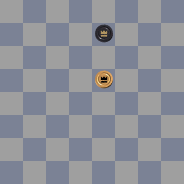If we can't play positions with three pieces reasonably well, what hope is there for us with thirty-two pieces on the board?
I'm not providing solutions to any of the positions below yet: get Mom or Grandpa to play the other side and see whether the two of you can figure this out together.
 |
| 1) White to play draws, Black to play loses |
Usually, you want it to be your turn to move. Here, neither player wants to be on move! (Nerd alert: the technical term is
reciprocal zugzwang.) When both kings can make it to the pawn's queening square, each player is trying to trick the other into a position like the one above.
*******
 |
| 2) White wins, no matter whose move it is |
 |
| 3) White to play wins, but watch out for stalemate! |
 |
| 4) White to play draws, Black to play loses |
In one-on-one basketball, what does the player with the ball do when the defender is in perfect position? Maybe a head fake: the attacker wants the defender to move in one direction so she can drive the lane in the other direction. The pawn's queening square (d8 in Position 4) is like the basket, and the Black king on d7 is a perfectly-placed defender: that's why Black doesn't want to move first! 1...Kc7 2.Ke6 or 1...Ke7 2.Kc6.
To understand Black's drawing technique with White to move, see Vince Hart's blog post,
Straight Back Draws. Compare Position 4 to Position 2: Position 2 is always lost because the Black King has
no room to go straight back! Of course, it's important to go straight back at the right time: 1.Kc5 Kd8?? loses because White can get to Position 2, but 1.Kc5 Kc7 2.d5 Kd7 and then....
 |
| 5) White wins, either player to move |
The rook pawn is a special case. Either king can be stalemated on the rook pawn's queening square:
 |
| 6) Rook pawns are weird: draw with either player to move |
 |
| 7) Rook pawns are very weird: Black to play draws |
What happens when the kings are far away from the pawn? It's good to know the
square of the pawn rule (much easier than "I go here, he goes there, I go here.." or counting on your fingers):
 |
| 8) White to play wins, Black to play draws |
 |
| 9) A tricky square to draw! |
Kings have elbows and should learn how to use them:
 |
| 10) White to play wins (in chess, the shortest distance between two squares is not necessarily a straight line!) |
|
 |
| 11) Black to play draws (Gligoric-Fischer, Candidates 1959) |
|
 |
| 12) White to play: what happens? Black to play: ditto? |
If you find the answer to Position 12 intuitive, you're a better player than I am! (Can White create Position 1 with Black to move?)
There's much more to know:
the Wikipedia article on king and pawn vs. king is a good place to continue. (Check out the 1908 study by Jan Drtina in the "Any key square by any route" section.) If you enjoy these endings, I can't recommend Müller & Lamprecht's
Secrets of Pawn Endings strongly enough: it's amazing that these seemingly simple positions are so complicated and so beautiful.
Experienced players will note that I avoided the "
O word"! I like to teach that by starting with a position from checkers:
 |
| Black to play loses; White to play draws |













4 comments:
What, no mention of full-point mutual zugzwang, as in the famous trébuchet position (White: K on e5, P on d4; Black: K on c4, P on d5)? http://bit.ly/OClyKT
Four pieces: too complicated!
Plus we've been there, though only briefly.
I wonder how many players have fallen into the trap in No. 3: 1.b6+?? Ka8!=. Correct is 1.Kc7! (box) Ka8 2.Kb6! (2.Kc6?! Ka7! repeats) Kb8 3.Ka6! (3.Kc6?! Ka7! repeats) Ka8 4.b6 Kb8 5.b7 Kc7 6.Ka7 and wins.
Fred - good point on #3; I teach kids to picture the T and control it so that ...b6 is avoided.
Post a Comment